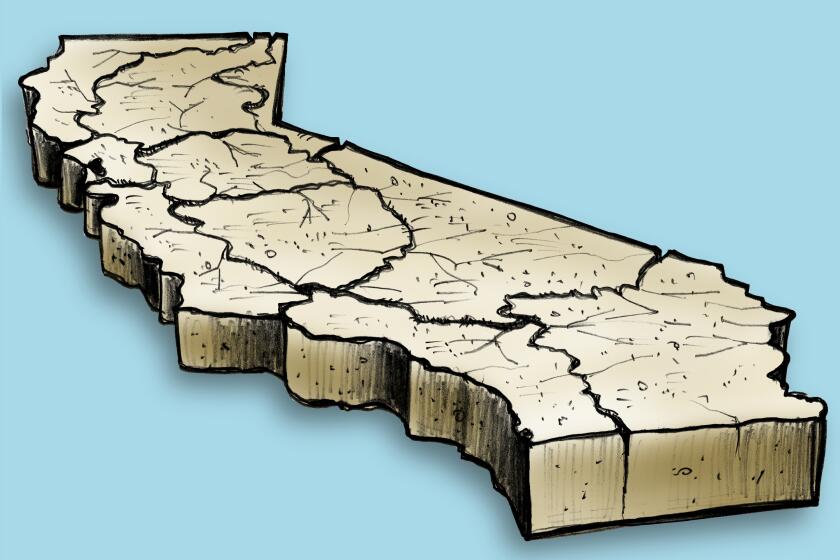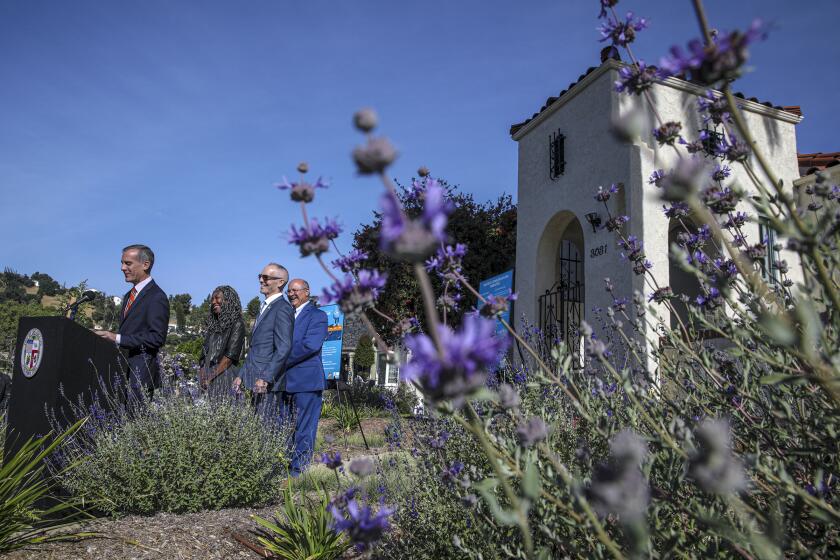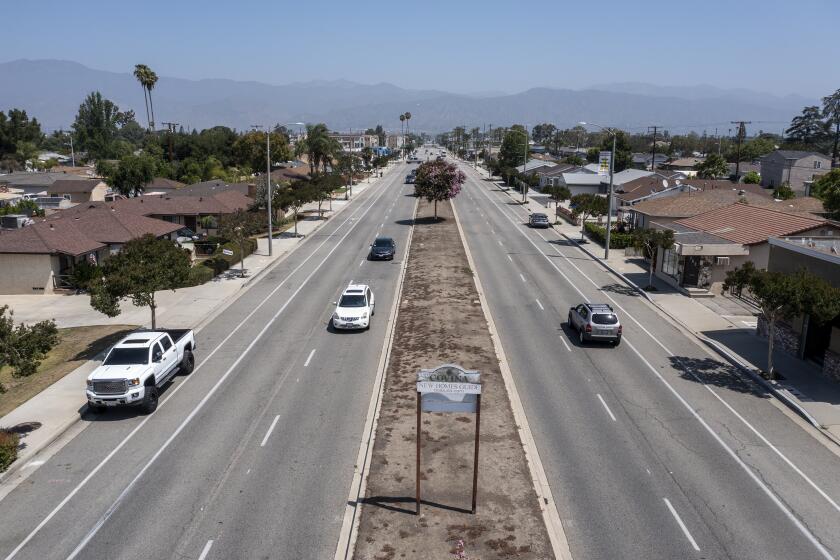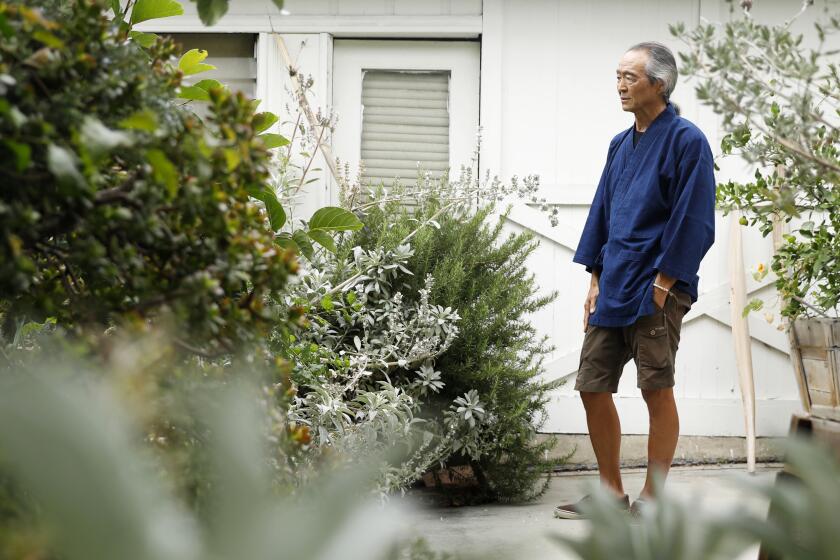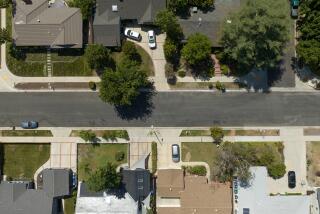L.A. water use plunges a record 9% as unprecedented water restrictions bring savings
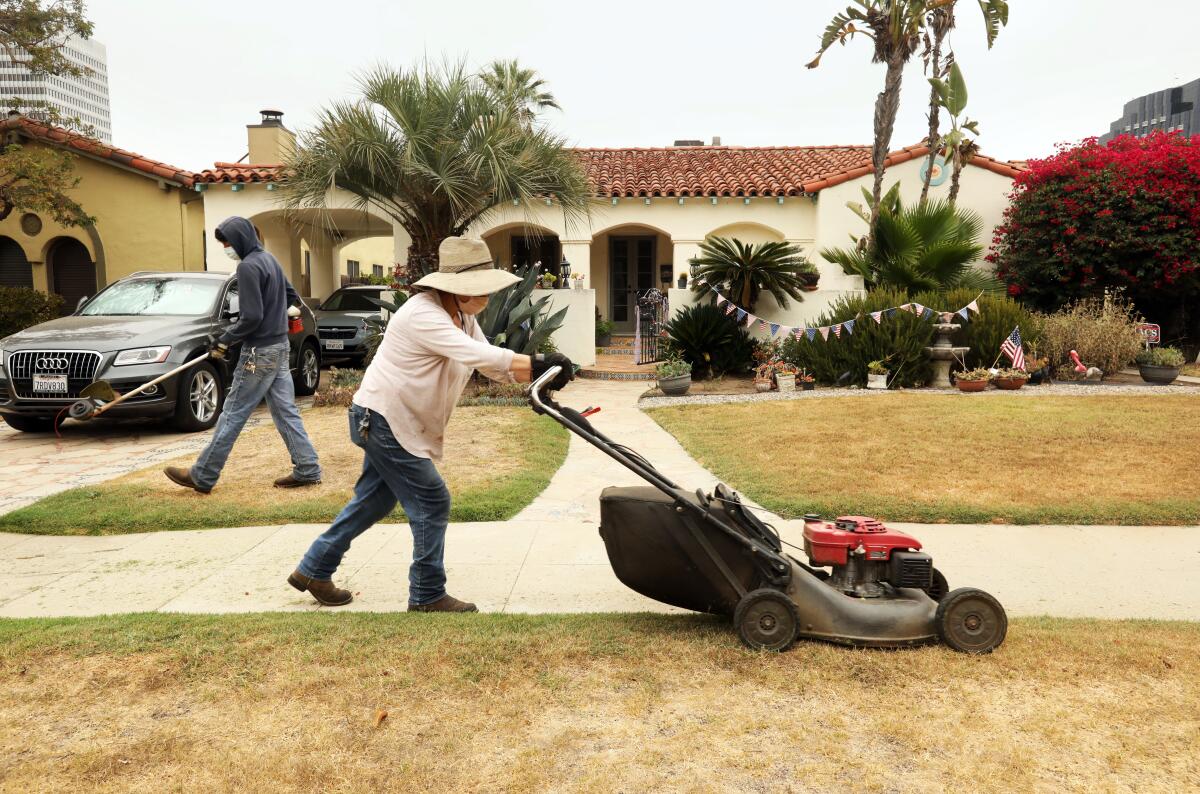
Damon Ayala peered at a wet patch of sidewalk on South Tremaine Avenue on a recent Wednesday and clicked his pen.
“No one should be watering today,” he said. “That’s evidence of a watering today. They’re going to get an information letter from me.”
Ayala is a member of the Los Angeles Department of Water and Power’s water conservation response unit, and he spends his days patrolling the streets of L.A. looking for homes and businesses in violation of the new drought rules. The restrictions went into effect June 1 and include the city’s strictest-ever outdoor watering limitations.
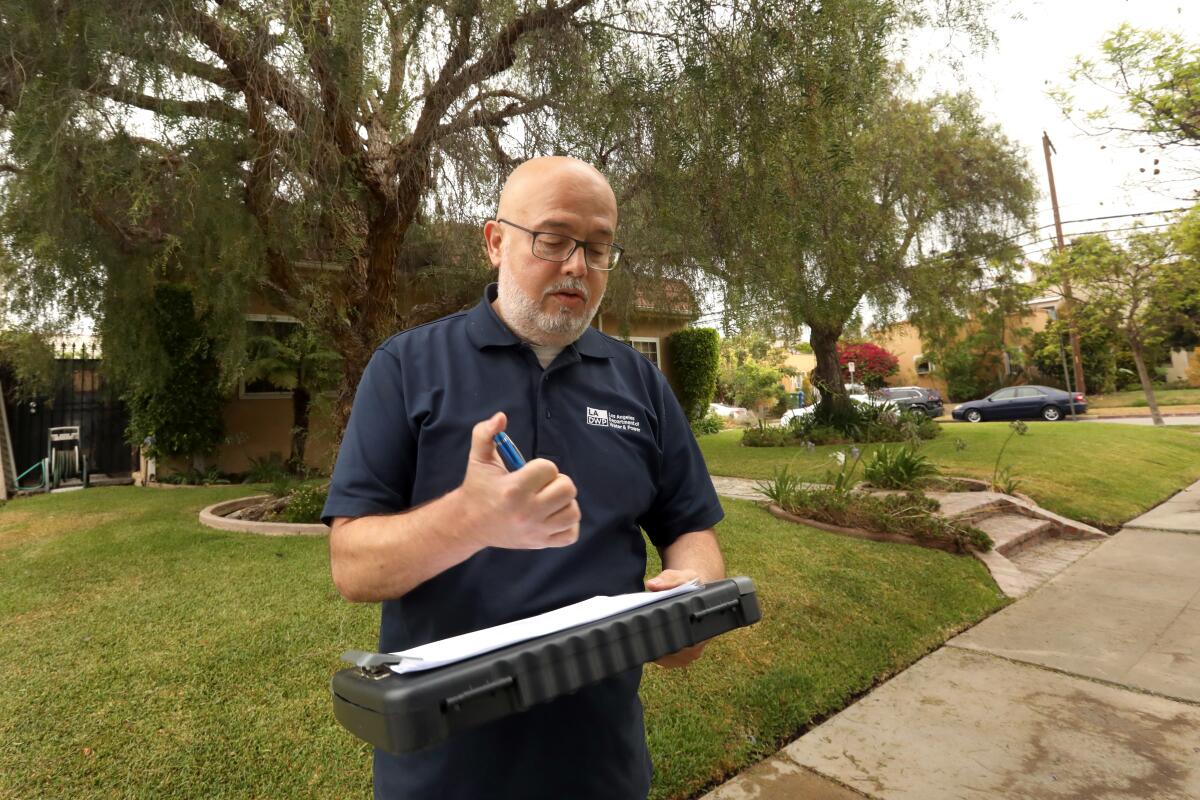
“We try to give our customers the benefit of the doubt that maybe they don’t know about the ordinance,” Ayala said as he scribbled down the address of a Mid-Wilshire home that appeared to be the source of the offending moisture. “This is why we’re doing what we’re doing now, and that way, we can initiate contact with them and then maybe they will be aware.”
The efforts appear to be working. During a board meeting Tuesday, DWP officials announced that demand for water from city residents plummeted 9% in June compared with the same month last year. It was the lowest water use for any June on record.
The latest maps and charts on the California drought, including water usage, conservation and reservoir levels.
“The city of L.A. is doing an absolutely fantastic job adhering to the message from the governor and reacting to the situation, which is the severe drought that we’re in right now,” Anselmo Collins, senior assistant general manager of water systems, told the board.
Under the new rules, L.A. residents with odd-numbered addresses can water on Mondays and Fridays, while those with even numbered addresses can water on Thursdays and Sundays.
Yet despite the positive report, it’s clear that some Angelenos are more on board with the restrictions than others. The Mid-Wilshire area where Ayala was patrolling is home to a patchwork of yards in varying conditions, including some glimmering green lawns next to others that were dead and browning.

Cathy Tuch, who has lived in her Mid-Wilshire home since 1980, said she was saddened by the visible effects of drought.
“I’m just really upset about what’s happening. My yard usually looks so green,” she said as she swept dead leaves and twigs into a bag.
Though she has been through drought restrictions in the past, she said this time feels different, harder.
“We’re going to have to replace a lot of stuff, especially the grass — it’s gone. It looks like hay,” she said. “It’s so sad.”
As California drought worsens, the DWP in Los Angeles will limit outdoor watering to two days a week, with watering capped at eight minutes per station.
The region’s massive water wholesaler, the Metropolitan Water District of Southern California, first issued its call for an unprecedented reduction in water use at the end of April. Some agencies opted to reduce residents to one-day-a-week outdoor watering restrictions, but others, including the DWP, chose instead to stay within a specific volumetric allocation.
“We believe that going to two-day-a-week watering and getting people to really pay attention and ramp down their water use will keep us within the allotment that Met has offered us,” DWP general manager and chief engineer Martin Adams said of the decision at the time.
Officials said the city was able to stay within its water budget during the first full month of restrictions, maintaining just under 112 gallons per person per day in June despite soaring temperatures that often drive consumption. In May — the month after the announcement — water demand dropped 3% compared with the same time last year.
“We put out the call to conserve and you responded swiftly and decisively,” Adams said in a statement about the figures. “But it’s early in the summer months and we need everyone to continue saving water wherever possible to help us navigate the rest of the summer when water use is typically higher.”
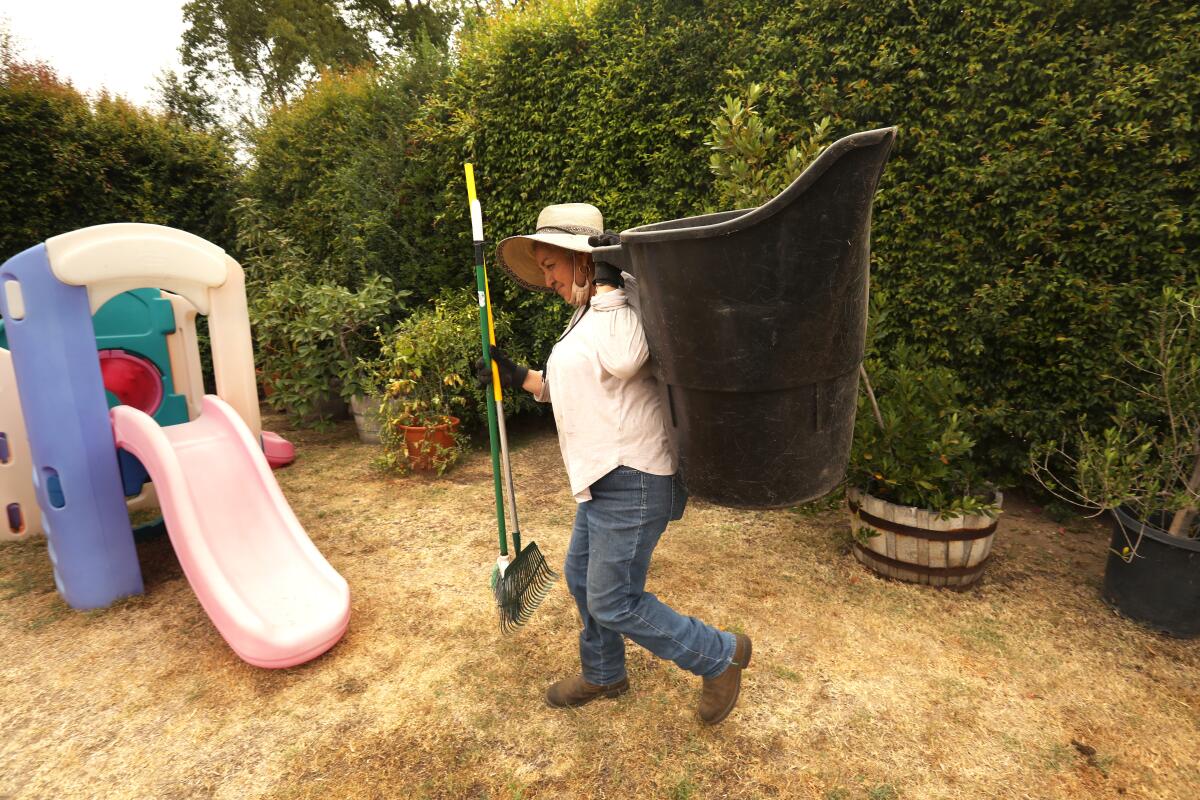
Water use is also starting to tick downward statewide, although officials with the State Water Resources Control Board last week similarly warned that much more needs to be done to reach the voluntary 15% savings Gov. Gavin Newsom called for last year.
But while some residents are working to make those adjustments, others just keep watering. Sprinklers at the home next door to Tuch’s sprayed a steady stream of water onto a half-green lawn last week, an apparent violation of the day’s watering rules.
The owner of that home, who declined to provide her name because she said she works in law enforcement, said she was aware of the ordinance but couldn’t figure out how to calibrate her decades-old system to the right days and times.
“There’s only two choices: on or off,” she said.
She noted that she makes other eco-friendly efforts, including driving an electric vehicle, hand-watering her garden and collecting water in buckets for reuse. But she also wasn’t convinced that the city’s water-saving efforts — including rebate programs for lawn replacement — were all that effective, and said she thought the money could be better spent helping the homeless.
“Is it just virtue-signaling to let our lawns turn brown?” she asked, adding that she doesn’t get why swimming pools, golf courses and almond trees are not subject to stronger rules.
More than 6 million Southern Californians will be placed under new drought rules today in an unprecedented effort to conserve water.
Statewide, average water use is roughly 50% environmental, 40% agricultural and 10% urban. However, officials have stressed that residential savings really do add up. Outdoor watering, in particular, is the biggest water waster in urban areas, and drought-tolerant and “California-friendly” landscaping can save up to 85% more water than grass, according to the MWD.
During the board meeting, Collins said requests for turf replacement rebates have soared since the restrictions were announced, with the number of applications in May and June more than double that of the same months last year.
“We’re at almost 300 requests in the last two months for turf replacement, which is by far the most popular rebate the department offers,” he said.
More than 51 million square feet of turf have been replaced in the city since the program began about a decade ago, he said.
In a statement Tuesday, Mayor Eric Garcetti emphasized the rebate programs and also called on residents to do more.
“As encouraging as this progress is, L.A. continues to shatter monthly heat records, and we are faced with the stark reality that this crisis is only deepening,” Garcetti said. “As the hottest months of the year approach, we’re asking Angelenos to not only maintain biweekly outdoor watering limits, but to find additional ways to cut back on their water usage by taking advantage of the nearly 20 LADWP rebates that help our ratepayers save money and have made Los Angeles one of the most water efficient cities in the country.”
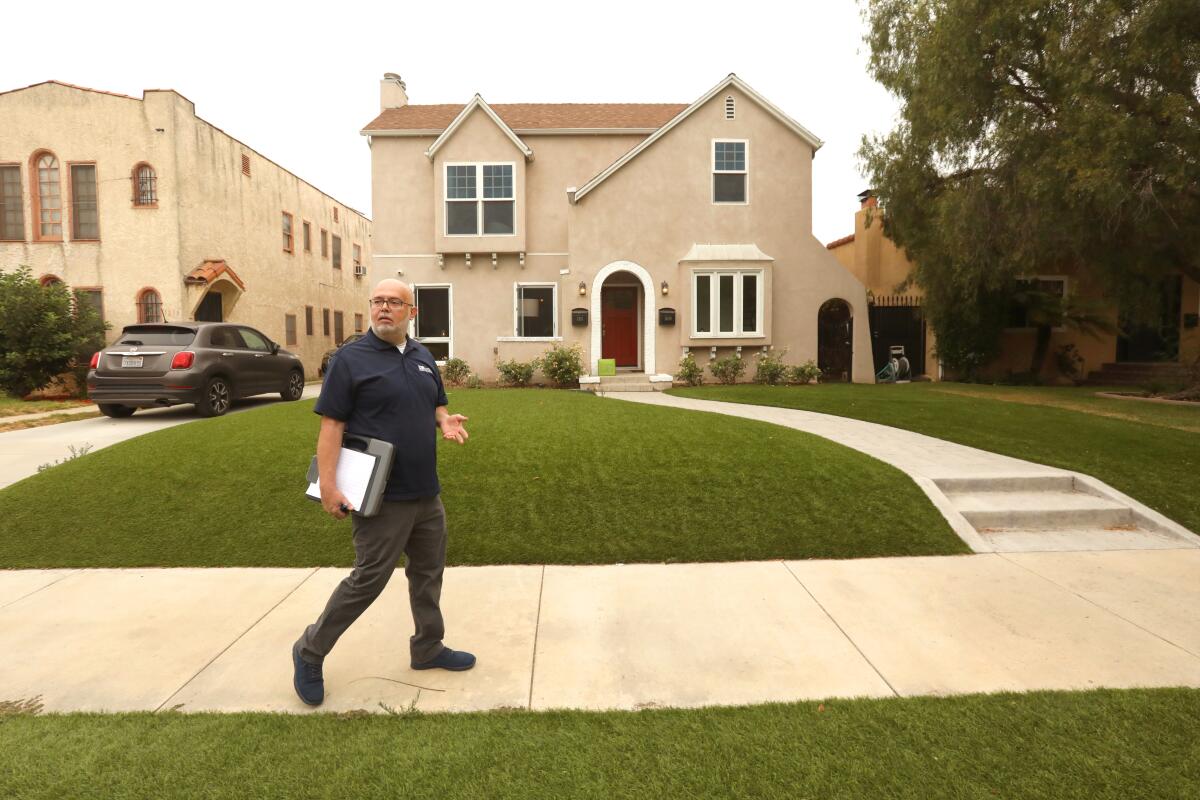
There are other signs of progress, too, including an increase in the number of water waste complaints. Collins said there were 3,000 complaints in May and June, more than twice the amount from the same months last year.
The DWP also issued 49 residential and commercial citations in the month of June, he said, noting that most were for “informational purposes” but that repeat offenders are subject to fines.
Ayala, the DWP patroller, said he would check to see whether the homeowner on South Tremaine Avenue had violated any rules in the past, which could warrant a monetary citation. But he also stressed that the goal of his work was education, not punishment, and said most weeks he issues hundreds of information letters and only a handful of tickets.
“If I have the opportunity to educate, that’s always the first option for me, always,” he said. “We obviously can issue a warning citation or a monetary citation, but what we’re really looking for is behavioral change.”
Georg Kochi moved to his family home and tore out the lawn. As he learned about native plants, he fell in love with drought-tolerant landscaping.
That change will be easier for some Angelenos than others. Gardener Adrian Ruiz said he’s never before dealt with only two watering days a week. He hopes he can revive some of his clients’ dying lawns in the winter if the rains return.
“A lot of customers are going to say, ‘I can’t have you no more,’ but at the same time, maybe I’ll get business doing landscaping work,” he said. One of his customers in Silver Lake has already approached him about converting her recently installed $6,000 grass lawn with something more drought tolerant.
“I think people are accepting it,” he said of the new rules.
But another gardener, Maria de la Cruz, said that she has already lost five of her 15 clients since the new rules kicked in, and that there is increasingly less work to do. She runs her small business with her son and one other employee.
“I feel sad because it’s ugly,” De la Cruz said after running a lawnmower across dead grass at a home in the Carthay area.
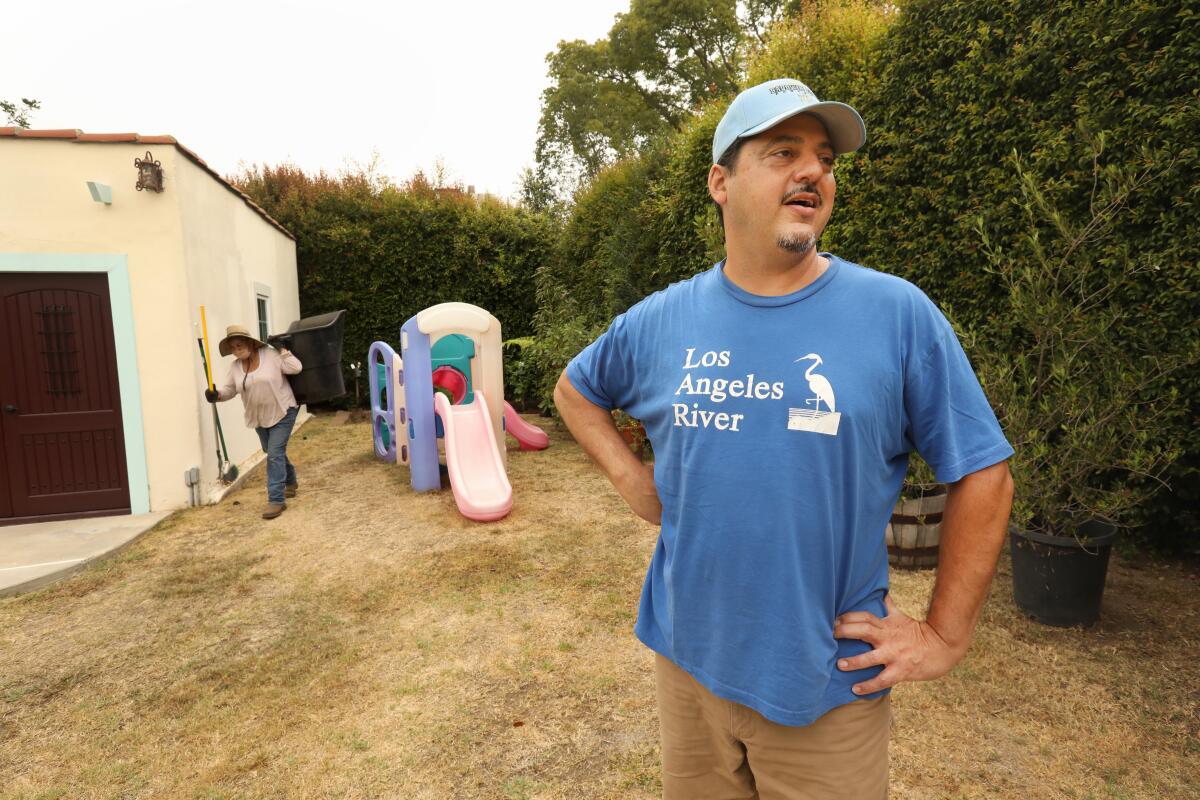
The home’s owner, Daniel Tellalian, said he planned to keep her team employed even though he let both his front and back yards die under the new restrictions.
“We’re a really neighborly block — we actually sit on our front lawns and convene and do versions of happy hours and things like that together, so it is kind of sad,” he said as he surveyed the sea of dead grass.
“But now we’ll just sit on our brown lawns,” he shrugged. “We’ll bring it back if conditions get better.”
More to Read
Sign up for Essential California
The most important California stories and recommendations in your inbox every morning.
You may occasionally receive promotional content from the Los Angeles Times.
